by Nic Haygarth | 25/05/20 | Tasmanian high country history
The man with the possum-skin bag on his back studied the rocks as he sloshed his way down the river with Bravo, his collie-spaniel cross. James ‘Philosopher’ Smith sought the motherlode of the Arthur River gold. Ahead of him, the low summer stream rippled as it received a tributary from the east. Smith’s partly speculative Henry Hellyer map suggested that this was the Waratah River. In its dark mouth he searched for wash—sand and detritus carried down by the current—and promising rock formations. At a sandbar he swirled something black in his dish which in the half-light resembled tin. He had seen tin oxide almost two decades earlier at the Victorian gold rushes, but the tiny quantity in his dish now caused him no excitement. He returned to the Arthur to resume his search for gold.
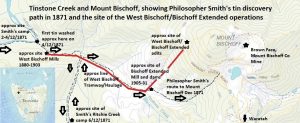
Base map courtesy of LISTmap (DPIPWE).
It was only two days later, when the sun’s rays poked through the myrtle forest, that the opportunity arose to examine the sample under the lens. What struck Smith about it was that many particles were angular. The sample was little waterworn, which meant he had found it close to the matrix.
Smith rushed back to the ‘Waratah’, which was actually today’s Tinstone Creek. For a further two days he panned and picked at the course of the stream, but it wasn’t until he ventured above its Ritchie Creek confluence that his pick opened the bed of porphyry he sought. The adrenalin must have pumped as he climbed the stream. Within a few minutes he obtained a quarter of a kilogram of tin ore. He picked crystals out of crevices in the creek bed, and at the source of one of its tributaries, where Mount Bischoff Co tailings were later piled, Smith washed more than a kilogram of tin to the dish. He had found the motherlode.[1]
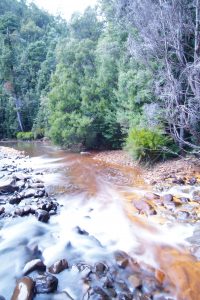
The site, at the junction of the Arthur River and Tinstone Creek, where Philosopher Smith washed the first Mount Bischoff tin. Today the startlingly yellow waters of Tinstone Creek tell the tale of Bischoff’s mining legacy. Nic Haygarth photos.
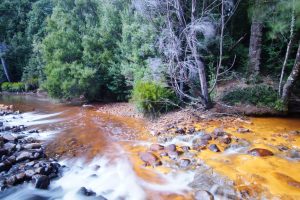
A ‘mountain of tin’, Mount Bischoff, stood above him. Over 74 years the Mount Bischoff Tin Mining Company would produce 56,000 tonnes of tin metal and pay dividends of more than £2.5 million on paid-up capital of only £29,600, one of the great success stories of Australian mining.
As usual, the company with the first choice of ground and best access to capital dominated the mining field. That wasn’t the West Bischoff Tin Mining Company which, ironically, worked in the valley where Smith made his discovery. Take a walk in Philosopher’s footsteps and you can see the scars of its struggle.
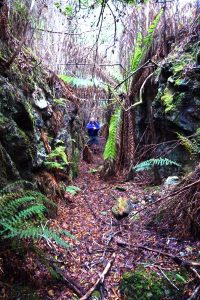
Sacrificial human showing the scale of a West Bischoff Tramway cutting, Tinstone Creek. Nic Haygarth photo.
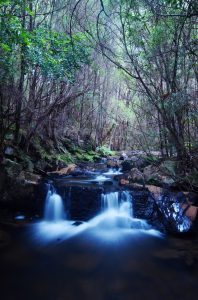
Ritchie Creek bustling through spindly regrowth. Here Philosopher got side-tracked for a day. Nic Haygarth photo.
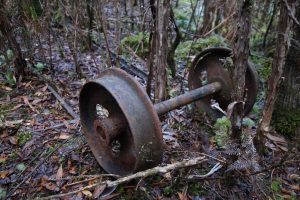
Bogey wheels from the horse-drawn tramway. Nic Haygarth photo.
The West Bischoff’s early mill site is not far from Philosopher’s discovery point near the junction of Tinstone Creek and the Arthur. That’s about as close as the company got to success. Here Cornish tin dressers WH Welsey and William White worked with a 15-head stamper battery driven by a 28-foot-diameter waterwheel. The plant was served by races from Ritchie Creek and the Arthur River, an inadequate water supply which probably reduced the company’s viability.[2] Beginning with a paid-up capital of £20,000, between 1878 and 1892 the West Bischoff Co made 26 calls on shares—and paid no dividends whatsoever.[3]
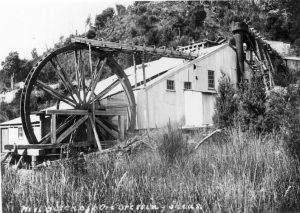
West Bischoff mill and water wheel. Stephen Hooker photo, NS1192-1-1 (Tasmanian Archive and Heritage Office).
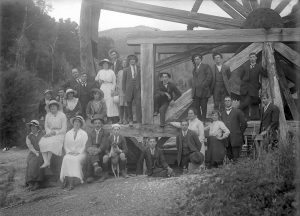
Friends of the water wheel, from the Colin Dennison Collection, University of Tasmania Archive, photo cleaned by Jeff Crowe.
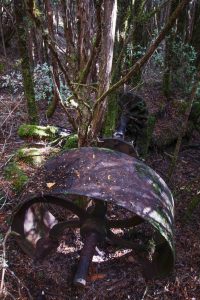
Machinery drive shaft still in place. Nic Haygarth photo.
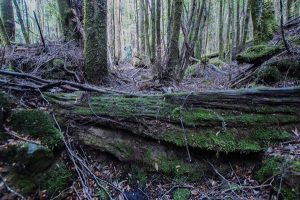
Some remaining timber fluming on a water
race. Nic Haygarth photo.
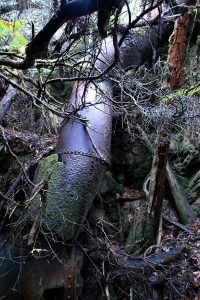
Collapsed boiler chimney in the old water wheel pit at the West Bischoff Mill. Nic Haygarth photo.
A 2.5km-long wooden, horse-drawn tramway and haulage connecting the plant to the mine in the western flank of Mount Bischoff included a 30-metre-long bridge over Ritchie Creek. [4] Thanks to Winston Nickols’ dogged research, track cutting and marking, much of the old tramline can now be retraced along the edge of the highly degraded Tinstone Creek. The impressive tramway cuttings and the horrible, spindly regrowth resulting from clearing the old forest give some idea of the original company’s enterprise. The yellow glop in the creek is fed by acid mine drainage (that is, low level sulphuric acid) escaping from the West Bischoff/Bischoff Extended adits.
By March 1892 the West Bischoff Co had driven its no.3 tunnel more than 400 metres, but the cost of all the infrastructure left it unable to afford a calciner which could have purified its ore by roasting out the arsenic.[5] The company was wound up, being replaced by another inadequately funded company, the New West Bischoff. The infrastructure on the property was by now so run down that it was cheaper to crush at the adjoining Stanhope Tin Mining Company battery than use its own, so the company employed Stanhope Co manager Richard Bailey to run the two mines concurrently.[6] While the New West Bischoff facilitated this change by building another tramway, in January 1893 its own plant was destroyed by bushfire.[7]
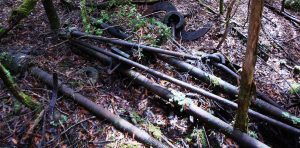
Stamper rods and part of the camshaft of the battery, West Bischoff/New West Bischoff Mill.
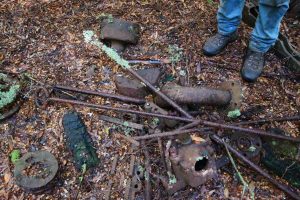
(Right) Charred remains of the blacksmith’s shop. Nic Haygarth photos.
The signs of this fire remain today at the multi-levelled site of the old mill, where the stamper rods, blacksmith’s shop, boiler stack and water wheel pit are still evident. The New West Bischoff lurched towards defeat. No Australian buyer wanted its unroasted arsenical tin ore, forcing it to ship it to England for treatment and sale.[8] The bank foreclosed on the company, finally selling the property to Wynyard investor Robert Quiggin in 1895.[9] After seventeen years of work at this site, the first dividend remained elusive.
The route from Waratah down Tinstone Creek to the Arthur River and over the Magnet Range was cut as a track in 1879, and when the mining settlement of Magnet was established in the 1890s it became an 8km pedestrian conduit between Waratah and its satellite mining town. Come night or day people padded between the centres, attending dances, courting darlings, cutting firewood and even moving stock. Today you rarely glimpse the ‘glorious’ walk of yesteryear, that ‘never-ending avenue of most beautiful greenery which arches overhead so closely at times as to form a veritable living tunnel’.[10]
No record survives of anyone hitching a ride up the hill on the West Bischoff tram, but those passing the old burnt-out mill site in 1901 would have dodged horse teams, haulage contractors and carpenters. A third company, the Mount Bischoff West Tin Mining Company, registered in Victoria, was building a new mill. It had paid-up capital of only £16,000, but a higher tin price in its favour.[11] Another crushing device, a Krupp ball mill, replaced the original battery and two concentrating tables were installed to separate the ore. The machinery was driven by a water-driven 98-horsepower turbine.[12] Drop in to see the concentrating tables and the amalgamating pan that possibly replaced the ball mill. The latter must have proven too hard to salvage when in 1903 the plant was abandoned and the property left in limbo again.
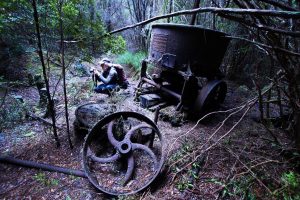
Pesky photo-bombing photographer with the amalgamating pan.
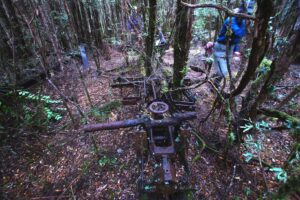
Phoenix Weir concentrating tables. Thanks to Winston Nickols for his technical research.
Nic Haygarth photos.
So far we have tarried in the bottom end of the Tinstone Creek valley. Now we cross Ritchie Creek, up which Philosopher camped after getting side-tracked trying to trace the tin. Above this confluence he rediscovered the black waterworn particles of the cassiterite or tin oxide that later made the Mount Bischoff Co famous. By the late 1890s this company had bought out most of its early rivals, but it saw no advantage in buying the West Bischoff property. Instead, in 1905 company number four, the West Bischoff Extended Tin Mining Company (later simply the Bischoff Extended), took over the leases and erected a new mill much higher up Tinstone Creek below its mine. When the scrub was lower than present you could still see the brick chimney and roaster shafts of its 1910 calciner, the first on the Bischoff field.[13]
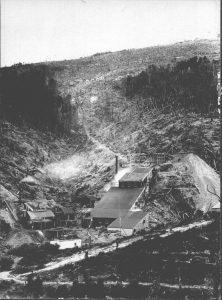
The first, steam-driven Bischoff Extended plant on Tinstone Creek, showing the tramway connecting it to the workings above it on the western side of Mount Bischoff. Photo courtesy of the Waratah Museum.
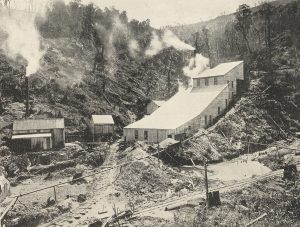
Bischoff Extended Mill, 1911. Photo probably by JH Robinson from the Weekly Courier, 25 May 1911, p.24.
From here on Mount Bischoff was a two-horse tin field. The better capitalised Mount Bischoff Co threw its weight around, alleging that the Bischoff Extended had encroached onto its lease. The expensive High Court law suit which resulted hampered the struggling company’s progress.[14] So did reduced production when World War One closed the European metal market.[15] The first dividend, 39 years in the making, was declared in 1917, but although several more followed up until 1920, the company soon returned to making calls on shares. Further technical advances, including electrification of the plant in 1925, were made in the face of rising costs and falling metal prices.[16] Mostly sporadic operation continued until the mine was abandoned in 1931.[17] A six-bullock team hauled a large boiler up the hill to Waratah, but much of the plant remains on site rusting ever deeper in the regrowth.[18] Welcome to the Tarkine industrial wilderness.
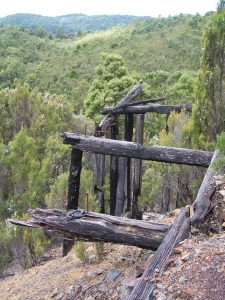
Life at the Bischoff Extended in 2004. Tiger snake sunning himself on burnt remains of the feed floor at the top of the mill.
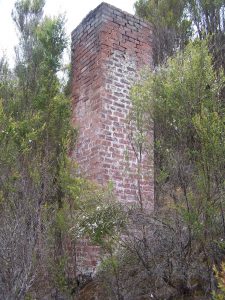
Calciner chimney.

Three lichen-encrusted roasting shafts crowned with gear wheels, Bischoff Extended Calciner. Nic Haygarth photos.
Your walk in Philosopher’s footsteps has now reached the base of the hill below Mount Bischoff. It’s a hard slog to the top, but imagine how much worse it was for the man on a daily ration of 100g of bread and a pint of tea.[19] That dish full of ‘black gold’ he won at the head of Tinstone Creek was the only tonic Smith needed. He had no food but he had a fortune. For the Mount Bischoff Co’s smaller rivals, destined to collect ‘the crumbs from the rich man’s table’, there was no pay-lode and no payday, just bread-and-butter toil for the working man and a poisonous legacy for the upper Arthur River.
[1] James Smith notes, ‘Exploring’, NS234/1/14/3 (Tasmanian Archive and Heritage Office, afterwards TAHO).
[2] HK Wellington; in DI Groves, EL Martin, H Murchie and HK Wellington, A century of tin mining at Mount Bischoff, 1871–1971, Geological Survey Bulletin, no.54, Department of Mines, Hobart, 1972, pp.61 and 64.
[3] Journal of the West Bischoff Tin Mining Company, NS1012/1/51 (TAHO).
[4] James FitzHenry, ‘Mount Bischoff’, Tasmanian Mail, 9 July 1881, p.21.
[5] Pretyman to FA Blackman, 23 March 1892, NS1012/1/45 (TAHO).
[6] Pretyman to Robert Mill, 25 August 1892, NS1012/1/45 (TAHO).
[7] For the tramway, see Pretyman to Richard Bailey, 7 December 1892, 14 December 1892 and 18 January 1893. For the fire, see Pretyman to Richard Bailey, 17 January 1893, NS1012/1/45 (TAHO).
[8] Pretyman to Richard Bailey, 29 September 1892; Pretyman to Claperton, 24 January 1894; NS1012/1/45 (TAHO).
[9] Pretyman to Richard Bailey, 9 August 1895, NS1012/1/45 (TAHO).
[10] ‘WGT’, ‘Further rambles with the Scouts’, Advocate, 26 January 1924, p.12.
[11] ‘Mount Bischoff West’, Examiner, 14 March 1901, p.2.
[12] ‘West Bischoff tin mine’, North Western Advocate and the Emu Bay Times, 26 September 1901, p.3.
[13] ‘Mount Bischoff Extended’, Advocate, 6 September 1907, p.2.
[14] ‘Bischoff Extended’, North Western Advocate and the Emu Bay Times, 30 May 1913, p.1.
[15] ‘Mount Bischoff Extended’, Daily Post, 18 May 1915, p.8.
[16] HK Wellington, A century of tin mining, p.58.
[17] HK Wellington, A century of tin mining, p.61.
[18] ‘Waratah: 8-ton boiler raised from Bischoff Extended’, Advocate, 24 March 1933, p.8.
[19] James Smith notes, ‘Exploring’, NS234/1/14/3 (TAHO).
by Nic Haygarth | 18/04/20 | Tasmanian high country history
When 52-year-old Maria Francis died of heart disease at Middlesex Station in 1883, Jack Francis lost not only his partner and mother to his child but his scribe.[1] For years his more literate half had been penning his letters. Delivering her corpse to Chudleigh for inquest and burial was probably a task beyond any grieving husband, and the job fell to Constable Billy Roden, who endured the gruesome homeward journey with the body tied to a pack horse.[2]

Base map courtesy of DPIPWE.
By then Jack seems to have been considering retirement. He had bought two bush blocks totalling 80 acres west of Mole Creek, and through the early 1890s appears to have alternated between one of these properties and Middlesex, probably developing a farm in collaboration with son George Francis on the 49-acre block in limestone country at Circular Ponds.[3]
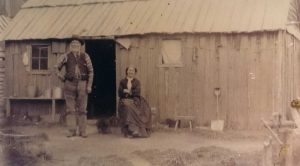
Jack Francis and second partner Mary Ann Francis (Sarah Wilcox), probably at their home at Circular Ponds (Mayberry) in the 1890s. Photo courtesy of Shirley Powley.
Here Jack took up with the twice-married Mary Ann (real name Sarah) Wilcox (1841–1915), who had eight adult children of her own.[4] Shockingly, as the passing photographer Frank Styant Browne discovered in 1899, Mary Ann’s riding style emulated that of her predecessor Maria Francis (see ‘Jack the Shepherd or Barometer Boy: Middlesex Plains stockman Jack Francis’). However, Mary Ann was decidedly cagey about her masculine riding gait, dismounting to deny Styant Browne the opportunity to commit it to posterity with one of his ‘vicious little hand cameras’.[5]
Perhaps Mary Ann didn’t fancy the high country lifestyle, because when Richard Field offered Jack the overseer’s job at Gads Hill in about 1901 he took the gig alone.[6] This encore performance from the highland stockman continued until he grew feeble within a few years of his death in 1912.[7]
Mary Ann seems to have been missing when the old man died. Son George Francis and Mary Ann’s married daughter Christina Holmes thanked the sympathisers—and Christina, not George or Mary Ann, received the Circular Ponds property in Jack’s will.[8] Perhaps Jack had already given George the proceeds of the other, 31-acre block at Mole Creek.[9]

Field stockmen Dick Brown (left) and George Francis (right) renovating the hut at the Lea River (Black Bluff) Gold Mine for WM Black in 1905. Ronald Smith photo courtesy of the late Charles Smith.
By the time Mary Ann Wilcox died in Launceston three years later, George Francis had long abandoned the farming life for the high country. He was at Middlesex in 1905 when he renovated a hut and took part in the search for missing hunter Bert Hanson at Cradle Mountain.[10] Working out of Middlesex station, he combined stock-riding for JT Field with hunting and prospecting.
Like fellow hunters Paddy Hartnett and Frank Brown, Francis lost a small fortune when the declaration of World War One in July 1914 closed access to the European fur market, rendering his winter’s work officially worthless. At the time he had 4 cwt of ‘kangaroo and wallaby’ (Bennett’s wallaby and pademelon) and 60 ‘opossum’ (brush possum?). By the prices obtaining just before the closure they would have been worth hundreds of pounds.[11] Sheffield Police confiscated the season’s hauls from hunters, who could not legally possess unsold skins out of season.
The full list of skins confiscated by Sheffield Police on 1 August 1914 gives a snapshot of the hunting industry in the Kentish back country. Some famous names are missing from the list. Experienced high country snarer William Aylett junior was now Waratah-based and may have been snaring elsewhere.[12] Bert Nichols was splitting palings at Middlesex by 1914 but may not have yet started snaring there.[13] Paddy Hartnett concentrated his efforts in the Upper Mersey, probably never snaring the Middlesex/Cradle region. His double failure at the start of the war—losing his income from nearly a ton of skins, and being rejected for military service—drove him to drink.[14]
‘Return of skins on hand on the 1st day of August [1914] and in my possession’, Sheffield Police Station.
| Name |
Location |
Kangaroo/wallaby |
Wallaby |
Possum |
| George Francis |
Msex Station |
448 lbs |
|
60 skins |
| Frank Brown |
Msex Station |
562 skins+ 560 lbs |
|
108 skins |
| DW Thomas |
Lorinna |
960 lbs |
|
310 skins |
| William McCoy |
Claude Road |
600 lbs |
|
66 skins |
| Charles McCoy |
Claude Road |
40 lbs |
|
|
| Geo [sic] Weindorfer |
Cradle Valley |
31 skins |
|
4 skins |
| Percy Lucas |
Wilmot |
408 skins |
|
56 skins |
| G Coles |
Storekeeper, Wilmot |
|
5 skins |
|
| Jack Linnane |
Wilmot |
|
15 skins |
|
| WM Black |
Black Bluff |
50 skins |
|
3 skins |
| James Perry |
Lower Wilmot |
|
2 skins |
13 skins |
Most of those deprived of skins were bush farmers or farm labourers who hunted as a secondary (primary?) income, while George Coles was probably a middleman between hunter and skin buyer:
Frank Brown (1862–1923). Son of ex-convict Field stockman John Brown, he was one of four brothers who followed in their father’s footsteps (the others were Humphrey Brown c1855–1925, John Thomas [Jacky] Brown, 1857–c1910 and Richard [Dick] Brown). He appears to have been resident stockman at Field brothers’ Gads Hill Station in 1892.[15] Frank and Louisa Brown were resident at JT Field’s Middlesex Station c1905–17. He died when based at Richard Field’s Gads Hill run in 1923, aged 59, while inspecting or setting snares on Bald Hill.[16]
David William Thomas (c1886–1932) of Railton bought an 88-acre farm on the main road at Lorinna from Harry Forward in 1912.[17] His 1914 skins tally suggests that farming was not his main source of income—so the loss must have been devastating. Other Lorinna hunters like Harold Tuson were working in the Wallace River Gorge between the Du Cane Range and the Ossa range of the mountains.
William Ernest (Cloggy) McCoy (1879–1968), brother of Charles Arthur McCoy below, was born to VDL-born William McCoy and Berkshire-born immigrant Mary Smith at Sheffield.[18] He was the grandson of ex-convict John McCoy and the uncle of the well-known snarer Tommy McCoy (1899–1952).[19]
Charles Arthur (Tibbly) McCoy (1870–1962) was born to VDL-born William McCoy and Berkshire-born immigrant Mary Smith at Barrington.[20] He was the grandson of ex-convict John McCoy. Charles McCoy caught a tiger at Middlesex, depositing its skins at the Sheffield Police Office on 30 December 1901.[21] He was the uncle of the later well-known snarer Tommy McCoy.
Gustav Weindorfer (1874–1932), tourism operator at Waldheim, Cradle Valley, during the years 1912 to 1932. By his own accounts during 1914 he shot 30 ‘kangaroos’, eight wombats, six ringtails and one brush possum, as well as taking one ‘kangaroo’ in a necker snare.[22] While the closure of the skins market would have handicapped this struggling businessman, these skins would have been useful domestically, and the wombat and wallaby meat would have gone in the stew.
Percy Theodore Lucas (c1886–1965) was a Wilmot labourer in 1914, which probably means that he worked on a farm.[23] Nothing is known about his hunting activities.
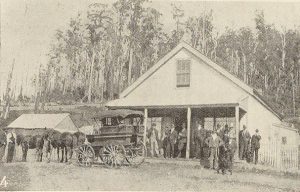
TJ Clerke’s Wilmot store, Percy Lodge photo from the Weekly Courier, 22 April 1905, p.19.
George Coles (1855–1931) was the Wilmot storekeeper whose sons, including George James Coles (1885–1977), started the chain of Coles stores in Collingwood, Victoria.[24] George Coles bought TJ Clerke’s Wilmot store in 1912, operating it until after World War One. In 1921 the store was totally destroyed by fire, although a general store has continued to operate on the same site up to the present.[25] The five skins in George Coles’ possession had probably been traded by a hunter for stores. Coles probably sold them to a visiting skin buyer when the opportunity arose.[26]
John Augustus (Jack) Linnane (1873–1949) was born at Ulverstone but arrived in the Wilmot district in 1893 at the age of nineteen, becoming a farmer there.[27] Like George Francis, Linnane joined the search party for missing hunter Bert Hanson at Cradle Mountain in 1905, suggesting that he knew the country well.[28] His abandoned hunting camp near the base of Mount Kate was still visible in 1908.[29] Enough remained to show that Linnane was one of the first to adopt the skin shed chimney for drying skins.[30] He also engaged in rabbit trapping.[31] In 1914 he was listed on the electoral roll as a Wilmot labourer, but exactly where he was hunting at that time is unknown.[32]
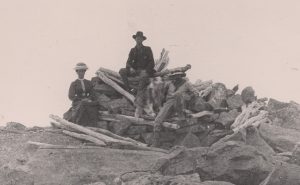
Kate Weindorfer, Ronald Smith and WM Black on top of Cradle Mountain, 4 January 1910. Gustav Weindorfer photo courtesy of the late Charles Smith.
Walter Malcolm (WM) Black (1864–1923) was a gold miner and hunter at the Lea River/Black Bluff Gold Mine in the years 1905–15. The son of Victorian grazier Archibald Black, WM Black was a ‘remittance man’, that is, he was paid to stay away from his family under the terms an out-of-court payment of £7124 from his father’s will.[33] He joined the First Remounts (Australian Imperial Force) in October 1915 by falsifying his age in order to qualify.[34] See my earlier blog ‘The rain on the plain falls mainly outside the gauge, or how a black sheep brought meteorology to Middlesex’.[35]
James Perry (1871–1948), brother of a well-known Middlesex area hunter, Tom Perry (1869–1928), who was active in the high country by about 1905. Whether James Perry’s few skins were taken around Wilmot or further afield is unknown.
No tigers at Middlesex/Cradle Mountain?
George Francis survived the financial setback of 1914. Gustav Weindorfer in his diaries alluded to collaboration with him on prospecting and mining activities, but they hunted in different areas. In 1919 Francis co-authored the three-part paper ‘Wild life in Tasmania’ with Weindorfer, which documented their extensive knowledge of native animals, principally gained by hunting them. At the time, the authors claimed, they were the only permanent inhabitants of the Middlesex-Cradle Mountain area, boasting nine years (Weindorfer) and 50 years’ (Francis) residency. They also made the interesting claim that the ‘stupid’ wombat survived as well as it did in this area because it had no natural predators, since the thylacine did not then and probably never had frequented ‘the open bush land of these higher elevations’.[36] While this suggests that George Francis had never encountered a thylacine around Middlesex, it’s hard to believe that his father Jack Francis didn’t, especially given the story that Jack’s early foray into the Vale of Belvoir as a shepherd for William Kimberley was tiger-riddled.[37] It’s also a pity the authors didn’t consult the likes of Middlesex tiger slayers Charlie McCoy (see above) and James Mapps—or rig up a séance with the late George Augustus Robinson and James ‘Philosopher’ Smith.
The dog of GA Robinson, the so-called ‘conciliator’ of the Tasmanian Aborigines, killed a mother thylacine on the Middlesex Plains in 1830.[38] Decades later, ‘Philosopher’ Smith the mineral prospector came to regard Tiger Plain, on the northern edge of the Lea River, as the most tiger-infested place he visited during his expeditions. It was popular among the carnivores, he thought, because the Middlesex stockman’s dogs by driving game in that direction provided a ready food source. ‘I thought it necessary’, he wrote about his experience with tigers,
‘to be on my guard against them by keeping a fire as much as I could and having at hand a weapon with which to defend myself in the event of being attacked by one or more of them … ‘[39]
Smith killed a female tiger on Tiger Plain and took its four pups from her pouch but found they could not digest prospector food (presumably damper, potatoes, bully beef, wallaby or wombat).[40] Philosopher’s son Ron Smith had no reason to doubt his father, as he found a thylacine skull on his property at Cradle Valley in 1913 which is now lodged in Launceston’s Queen Victoria Museum and Art Gallery.[41] There were still tigers in the Middlesex region at the cusp of the twentieth century. Like ‘Tibbly’ McCoy, James Mapps claimed a government thylacine bounty at this time, probably while working as a tributor at the Glynn Gold Mine at the top of the Five Mile Rise near Middlesex.[42]
George Francis in his will described himself as a ‘shepherd of Middlesex Plains’, yet he met his maker in the Campbell Town Hospital. His parents were dead and he had no remaining relatives. The sole beneficiary of his will was Golconda farmer and road contractor William Thomas Knight (1862–1938), probably an old hunting mate.[43] Francis’s job at Middlesex was filled by the so-called ‘mystery man’ Dave Courtney (see my blog ‘Eskimos and polar bears: Dave Courtney comes in from the cold’), whose life, as it turns out, is an open book compared to that of his elusive predecessor.
[1] Died 11 October 1883, death record no.167/1883, registered at Deloraine, RGD35/1/52 (TAHO), https://librariestas.ent.sirsidynix.net.au/client/en_AU/names/search/results?qu=maria&qu=francis#, accessed 15 February 2020; inquest dated 13 October 1883, SC195/1/63/8739 (TAHO), https://stors.tas.gov.au/SC195-1-63-8739, accessed 15 February 2020. A pre-inquest newspaper reporter incorrectly attributed her death to suicide by strychnine poisoning (editorial, Launceston Examiner, 23 October 1883, p.1).
[2] It is likely that Jack Francis and Gads Hill stockman Harry Stanley conveyed Maria Francis’s body to Gads Hill Station, where Roden took delivery of it. See ‘A veteran drover’, Examiner, 7 March 1912, p.4; and ‘Supposed case of poisoning at Chudleigh’, Launceston Examiner, 13 October 1883, p.2. Later Roden had the job of removing Stanley’s body for an inquest at Chudleigh (Dan Griffin, ‘Deloraine’, Tasmanian Mail, 13 August 1898, p.26).
[3][3] For the land grant, see Deeds of land grants, Lot 5654RD1/1/069–71In 1890, 1892 and 1894 John and George Francis were both listed as farmers at Mole Creek (Wise’s Tasmanian Post Office directory, 1890–91, p.200; 1892–93, p.288; 1894–95, p.260). Jack Francis was reported to have left Middlesex in March 1885, being replaced by Jacky Brown (James Rowe to James Norton Smith, 10 March 1885; and to RA Murray, 24 September 1885, VDL22/1/13 [TAHO]). However, he appears to have returned periodically.
[4] She was born to splitter John Wilcox and Rosetta Graves at Longford on 17 July 1841, birth record no.3183/1847 (sic), registered at Longford, RGD32/1/3 (TAHO), https://librariestas.ent.sirsidynix.net.au/client/en_AU/all/search/results?qu=sarah&qu=wilcox, accessed 14 March 2020; died 25 October 1915 at Launceston (‘Deaths’, Examiner, 8 November 1915, p.1). Mary Ann’s youngest child, Eva Grace Lowe, was born in 1879.
[5] Frank Styant Browne, Voyages in a caravan: the illustrated logs of Frank Styant Browne (ed. Paul AC Richards, Barbara Valentine and Peter Richardson), Launceston Library, Brobok and Friends of the Library, 2002, p.84.
[6] Wise’s Tasmanian Post Office directory for the period 1901–08 listed Jack Francis as an overseer at Gads Hill or Liena, while Mary, as she was described, was listed as a farmer at Liena, meaning Circular Ponds (1901, p.322; 1902, p.341; 1904, p.204; 1906, p.189; 1907, p.192; 1908, p.197).
[7] ‘A veteran drover’.
[8] ‘Return thanks’, Examiner, 2 March 1912, p.1; purchase grant, vol.36, folio 116, application no.3454 RP, 1 July 1912.
[9] Jack Francis bought purchase grant vol.18, folio 113, Lot 5654, on 25 November 1872. He divided it in half, selling the two lots on 6 May 1902 to Arthur Joseph How and Andrew Ambrose How for £30 each.
[10] ‘The mountain mystery: search for Bert Hanson’, North Western Advocate and the Emu Bay Times, 1 August 1905, p.3.
[11] 1 August 1914, ‘Daily Record of Crime Occurrences Sheffield 1901–1916’, POL386/1/1 (TAHO).
[12] See ‘William Aylett: career bushman’ in Simon Cubit and Nic Haygarth, Mountain men: stories from the Tasmanian high country, Forty South Publishing, Hobart, 2015, pp.42–43.
[13] See ‘Bert Nichols: hunter and overland track pioneer’, in Simon Cubit and Nic Haygarth, Mountain men: stories from the Tasmanian high country, Forty South Publishing, Hobart, 2015, p.114.
[14] See ‘Paddy Hartnett: bushman and highland guide’, in Simon Cubit and Nic Haygarth, Mountain men: stories from the Tasmanian high country, Forty South Publishing, Hobart, 2015, p.93.
[15] On 20 April 1892 (p.179) Frank Brown reported stolen a horse which was kept at Gads Hill, Deloraine Police felony reports, POL126/1/2 (TAHO).
[16] ‘Well-known stockrider’s death’, Advocate, 4 June 1923, p.2.
[17] ‘Lorinna’, North West Post, 28 August 1912, p.2; ‘Obituary: Mr DW Thomas, Railton’, Advocate, 21 April 1932, p.2.
[18] Born 21 March 1879, birth record no.2069, registered at Port Sorell, RGD33/1/57 (TAHO), https://librariestas.ent.sirsidynix.net.au/client/en_AU/names/search/results?qu=william&qu=ernest&qu=mccoy. Accessed 10 April 2020.
[19] Born 26 June 1870, birth record no.1409/1870, registered at Port Sorell, RGD33/1/48 (TAHO), https://librariestas.ent.sirsidynix.net.au/client/en_AU/names/search/results?qu=charles&qu=mccoy, accessed 15 September 2019; died 23 September 1962, buried in the Claude Road Methodist Cemetery (TAMIOT). For John McCoy as a convict tried at Perth, Scotland in 1792 and transported on the Pitt in 1811, see Australian convict musters, 1811, p.196, microfilm HO10, pieces 5, 19‒20, 32‒51 (National Archives of the UK, Kew, England).
[20] Born 26 June 1870, birth record no.1409/1870, registered at Port Sorell, RGD33/1/48 (TAHO), https://librariestas.ent.sirsidynix.net.au/client/en_AU/names/search/results?qu=charles&qu=mccoy, accessed 15 September 2019; died 23 September 1962, buried in the Claude Road Methodist Cemetery (TAMIOT). For John McCoy as a convict tried at Perth, Scotland in 1792 and transported on the Pitt in 1811, see Australian convict musters, 1811, p.196, microfilm HO10, pieces 5, 19‒20, 32‒51 (National Archives of the UK, Kew, England).
[21] 30 December 1901, ‘Daily Record of Crime Occurrences Sheffield 1901–1916’, POL386/1/1 (TAHO).
[22] Gustav Weindorfer diaries, 1914, NS234/27/1/4 (TAHO).
[23] Commonwealth Electoral Roll, Division of Wilmot, Subdivision of Kentish, 1914, p.27.
[24] ‘About people’, Age, 22 December 1931, p.8.
[25] ‘Fire at Sheffield [sic]’, Mercury, 8 November 1921, p.5.
[26] Coles held a tanner’s licence in 1914 (‘Tanners’ licences’, Tasmania Police Gazette, 1 May 1914, p.109), but the legal requirement was that skins had to be sold to a registered skin buyer. Despite this, plenty of people tanned and sold their own skins privately.
[27] ‘”Back to Wilmot” celebration’, Advocate, 12 April 1948, p.2.
[28] 10 July 1905, ‘Daily Record of Crime Occurrences Sheffield 1901–1916’, POL386/1/1 (TAHO).
[29] Ronald Smith, account of trip to Cradle Mountain with Bob and Ted Addams, January 1908, held by Peter Smith, Legana.
[30] Ronald Smith, account of trip to Cradle Mountain with Bob and Ted Addams, January 1908, held by Peter Smith, Legana.
[31] On 18 April 1910, Linnane reported the theft of 200 rabbit skins from his hut valued at £2, ‘Daily Record of Crime Occurrences Sheffield 1901–1916’, POL386/1/1 (TAHO).
[32] Commonwealth Electoral Roll, Division of Wilmot, Subdivision of Kentish, 1914, p.26.
[33] ‘Supreme Court’, Age, 27 February 1885, p.6.
[34] World War One service record, https://www.awm.gov.au/people/rolls/R1791278/, accessed 22 March 2020.
[35] Nic Haygarth website, http://nichaygarth.com/index.php/tag/walter-malcom-black/, accessed 22 March 2020.
[36] G Weindorfer and G Francis, ‘Wild life in Tasmania’, Victorian Naturalist, vol.36, March 1920, p.158.
[37] ‘The Tramp’ (Dan Griffin), ’In the Vale of Belvoir’, Mercury, 15 February 1897, p.2.
[38] George Augustus Robinson, Friendly mission: the Tasmanian journals and papers of George Augustus Robinson, 1829-1834 (ed. Brian Plomley), Tasmanian Historical Research Association, Hobart, 1966; 22 August 1830, p.159.
[39] James Smith to James Fenton, 14 November 1890, no.450, NS234/ 2/1/15 (TAHO).
[40] ‘JS (Forth)’ (James Smith), ‘Tasmanian tigers’, Launceston Examiner, 22 November 1862, p.2.
[41] Ron Smith to Kathie Carruthers, 26 September 1911, NS234/22/1/1 (TAHO); email from Tammy Gordon, QVMAG, 2019.
[42] Bounty no.242, 30 August 1898, LSD247/1/ 2 (TAHO); ‘Court of Mines’, Launceston Examiner, 22 September 1897, p.3; 30 September 1897, p.3.
[43] Will no.14589, administered 7 March 1924, AD960/1/48, p.189 (TAHO), https://librariestas.ent.sirsidynix.net.au/client/en_AU/names/search/results?qu=george&qu=francis, accessed 15 March 2020; ‘Funeral of Mr WF [sic] Knight’, Examiner, 15 April 1938, p.15.
by Nic Haygarth | 18/04/20 | Tasmanian high country history
When it comes to mythology, James ‘Philosopher’ Smith (1827–97), discoverer of the phenomenal tin deposits of Mount Bischoff in north-western Tasmania, has copped the lot. He was a mad hatter who ripped off the real discoverer, didn’t know tin when he saw it, threw away a fortune in shares (didn’t collect a single Mount Bischoff Co dividend) and ended up having to be saved from himself with a government pension.[1] Some of this hot air is still in circulation today—hopefully giving no one Legionnaire’s disease.
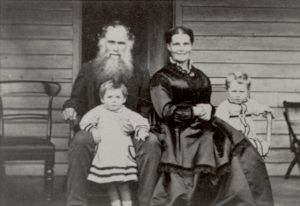
James ‘Philosopher’ Smith, wife Mary Jane and children Annie (left) and Leslie (right) at their near the Forth Bridge, 1877 or 1878. Peter Laurie Reid photo courtesy of the late Charles Smith.

Base map courtesy of DPIPWE.
Unbeknownst to Fields’ Middlesex Plains stockman Jack Francis, he has also been mired in Smythology. My favourite version of how Jack Francis rescued—or might have rescued, given the chance—Philosopher Smith during his Mount Bischoff expedition is this published poem by E Slater:
‘How Mount Bischoff was found’
Philosopher Smith was full of go,
He tried lots of times to get through the snow,
With his swag on his back he was not very slow,
And he crawled through the bush when his tucker was low.
So he had to turn back, to Jack Francis he came,
To the stockriders’ hut on Middlesex Plains,
I was in the hut when the old man came in,
And gave him some whisky, I think it saved him.
He told us quite plain that the tin it was there,
So he never gave in, or did not despair,
He got some more tucker and went out again,
This time he found Bischoff (it was teeming with rain).[2]
Not content with having Francis save a teetotaller with a bottle of whisky, this bold author decided to mooch in on the tall tale and make himself the saviour. The poem continues, inexplicably, to describe Smith’s triumphant return from Bischoff to the Middlesex Hut after finding the tin and his exit right via Gads Hill and Chudleigh.
Why would Smith take that circuitous route home? At the time, he owned the property Westwood at Forth, but he was also renting land at Penguin while he was involved in opening up the Penguin Silver Mine.[3] At least one author has claimed that Smith’s definitive prospecting expedition was mounted from Penguin up the Pine Road he had had cut in 1868 to enable piners to exploit the forests at Pencil Pine Creek near Cradle Mountain.[4]
However, in his notes Smith made it clear that he travelled from Forth via Castra, the logical route from Westwood to the gold-bearing streams of the Black Bluff Range and the mineralised country around the Middlesex Plains. His main plan was to test the headwaters of the Arthur River for a gold matrix, in support of which he had had a stash of supplies packed out to the base of the Black Bluff Range.
And so, according to Tasmania’s late-nineteenth-century Book of Genesis, James Smith unearthed hope and prosperity in the form of tin at Mount Bischoff on 4 December 1871. What Smith’s notes tell us is that, after a week of work at Mount Bischoff, he ran out of food and—with apologies to those who have claimed he ate his dog[5]—retreated to the hut of Field’s Surrey Hills stockman-hunter Charlie Drury to beg a feed. Drury, not Francis, was the stockman Smith recalled meeting during his Mount Bischoff expedition.[6]
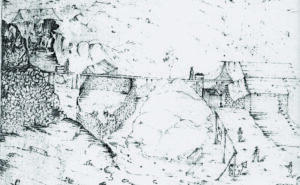
Action from the
Slaughteryard Gully Face of the Mount Bischoff Tin Mine, c1876, showing the yarding and slaughter of stock reflected in its name. Courtesy of the late Charles Smith.
Regardless of Jack Francis’s non-glorification in the discovery of Bischoff, the tin mine brought a benefit to the denizens of Middlesex Station. The advent of the town of Mount Bischoff (Waratah), from about 1873, brought them closer to civilisation. However, there was no Mount Bischoff Tramway until 1877, and in its early days the town had no resident doctor. This meant that when a kick from a horse broke Jack Francis’s thigh at Middlesex in 1875, the nearest medical help was the unqualified ‘Dr’ Edward Brooke Evans (EBE) Walker of Westbank, Leven River (West Ulverstone). The round trip from the coast to Middlesex Station via the VDL Co Track—about 240 km—must have taken several days each way. ‘I had a nice jaunt to Middlesex’, Walker reported,
‘JT Field wrote asking me to go there to see a poor fellow a stock rider who had broken his thigh eight weeks before offering me £10!! to go there … I had to break it as it was 4 inches [9 cm] too short … I wrote and told him [JT Field] that he ought to supplement his offer but have had no answer … ‘[7]
Despite the pain, Jack—and/or his wife Maria Francis—made good use of this ‘down’ time, assembling a 30-shilling possum skin rug. ‘The rivers are not always fordable otherwise you would have the rugs more certain’, Jack told a customer, Van Diemen’s Land Company (VDL Co) local agent James Norton Smith.[8] He could ride, but for years the thigh injury still prevented him from walking far. In 1881 he asked the VDL Co to give him free passage to Waratah on the company’s horse-drawn tramway, enabling him to ride there after hitching his horse at the Surrey Hills stop.[9]
The establishment of Waratah also raised the Francis family’s social profile. One-time recipients of Her Majesty’s pleasure (they were both ex-convicts) became vice-regal hosts. In January 1878 Jack, Maria and possibly young George Francis put up Lieutenant Governor Frederick Weld at Middlesex Station. Escorted by a young Deloraine Superintendent of Police, Dan Griffin, and guided by Thomas Field, the vice-regal party negotiated Gads Hill on its way to visit the new mining capital—Weld being the first governor since George Arthur to tackle the VDL Co Track.[10] So it was that Jack Francis scored his moment of glory without even tempting the temperate Philosopher.
[1] For Smith finding the Mount Bischoff tin in the hut of stockman Charles Drury (‘Dicey’), see ‘The story of Bischoff’, Advocate, 24 April 1923, p.4. For Smith failing to identify the tin when he saw it, see, for example, Ferd Kayser, ‘Mount Bischoff’, Proceedings of the Australasian Association for the Advancement of Science (ed. A Morton), vol.iv, Hobart, 1892, p.342. For Smith squandering a fortune and having to be saved by the Tasmanian Parliament see, for example, ‘Parliamentary notes’, Launceston Examiner, 21 October 1878, p.2. For Smith ‘not making a cent’ out of Mount Bischoff tin and not collecting a single dividend from the Mount Bischoff Tin Mining Co, see, for example, Carol Bacon, ‘Mount Bischoff’; in (ed. Alison Alexander), The companion to Tasmanian history, Centre for Tasmanian Historical Studies, University of Tasmania, Hobart, 2005, p.243.
[2] E Slater, ‘How Mount Bischoff was found’, Waratah Whispers, no.15, March 1982; reprinted there from ‘an old newspaper cutting’.
[3] Application to register the Penguin Silver Mines Company was gazetted on 23 August 1870. The assessment roll for the district of Port Sorell for 1870 lists Smith as the occupant of a hut on 47 acres at Penguin owned by Thomas Giblin of Hobart (Hobart Town Gazette, 22 February 1870, p.298).
[4] See ‘Penguin old and new: record of great development’, Weekly Courier, 17 December 1927, p.35.
[5] See, for example, ‘Nomad’, ’Correspondence: Philosopher Smith’, Circular Head Chronicle, 25 May 1927, p.3.
[6] James Smith notes, ‘Exploring’, NS234/1/14/3 (TAHO).
[7] EBE Walker to James Smith, 8 July 1875, NS234/3/1/4 (TAHO).
[8] Jack Francis to James Norton Smith, 13 October 1875, VDL22/1/5 (TAHO).
[9] Jack Francis to James Norton Smith, 11 April 1881, VDL22/1/9 (TAHO).
[10] ‘Vice-regal’, Tribune, 28 January 1878, p.2; ‘DDG’ (Dan Griffin), ‘Vice-royalty at Mole Creek’, Examiner, 15 March 1918, p.6.
by Nic Haygarth | 03/04/20 | Story of the thylacine, Tasmanian high country history
In 1945 one-time wrestler George Randall (1884–1963) recalled catching fifteen thylacines in the space of a month within 25 miles (40 km) of Burnie. He didn’t smother them in a bear hug. Randall reminisced that, upon finding tiger scats, he would lay a scent for half a mile from that point to his snares. The cologne no tiger could resist was actually the smell of bacon rubbed onto the soles of his boots.[1]

Champion wrestler George Randall, from the Weekly Courier, 18 February 1909, p.18.
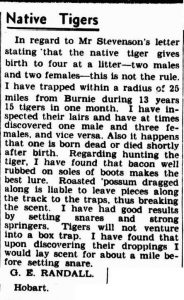
George Randall in the Mercury, 12 December 1945, p.3.
Fifteen tigers—a big boast indeed. I was suspicious of those numbers. Who was Randall, and if he was such an ace tiger killer why had he never claimed a government thylacine bounty? Government bounties of £1 for an adult tiger and 10 shillings for a juvenile were paid in the years 1888 to 1909, after all, plenty of time in which he could leave his mark. The production of a carcass at a police station was the basis for a bounty application.
Randall was born at Burnie to George Ely Randall (1857–1907) and Emily Randall, née Charles (1871–1938).[2] By 1891 his father George Randall senior was a ganger maintaining the Emu Bay Railway (EBR) at Ridgley, south of Burnie. There were some tigers about, and it didn’t take much effort to find some Randalls killing one. In May 1892 Tom Whitton, who was aware of tigers coming about the gangers’ camp at night, set some snares and caught a large male. Two Randalls, George senior and his brother Charles, plus a fettler named Ted Powell, were at hand to help throttle the beast.
Wellington Times editor Harris added: ‘The tiger’s head was inspected by a large number of persons up to yesterday, many of whom remarked that they had never seen larger from a native animal; but yesterday the head had to be thrown away as it was manifesting signs of decay.’[3]
Thrown away?! So much for the £1 bounty. Perhaps the killers were too bloated on public admission fees to care about the bounty payment.
Another Randall killing came only two months later, when Powell and Charles Randall’s dogs flushed a tiger out of the bush at the 23-Mile on the EBR. Again the body was hauled into Burnie as a trophy.[4] Was a £1 government reward paid?
The government bounty records for the period May–July 1892 show the difficulty of reconciling newspaper reports with official records. There is no evidence of a bounty application having been made for the tiger killed on the EBR on 13 May 1892, but the one destroyed there in the week preceding 12 July 1892 is problematical. Was James Powell, who submitted a bounty application on 8 July, a relation of Ted Powell, the fettler involved in the two killings on the EBR? I could find no record of a James Powell working or residing in the Burnie area at that time, whereas two James Powells in pretty likely tiger-killing professions—manager of a highland grazing run, and bush farmer under the Great Western Tiers—were easily identified through digitised newspaper and genealogical records (see Table 1):
Table 1: Government thylacine bounty payments, May–July 1892, from Register of general accounts passed to the Treasury for payment, LSD247/1/1 (TAHO).
| Name |
Identification |
Application date |
Number |
| G Atkinson |
Probably farmer George Elisha Atkinson of Rosevears, West Tamar |
13 June 1892 |
2 adults[5] |
| A Berry |
Probably shepherd Alfred James Berry, Great Lake, Central Plateau |
21 July 1892 |
1 adult[6] |
| John Cahill |
Farmer/prospector, Stonehurst, Buckland, east coast |
8 July 1892 |
1 adult[7] |
| WF Calvert |
Wool-grower/orchardist William Frederick Crace Calvert, Gala, Cranbrook, east coast |
21 July 1892 |
4 adults[8] |
| J Clifford |
Probably bush farmer/hunter Joseph Clifford of Ansons Marsh, north-east |
12 May 1892 |
1 adult[9] |
| Harry Davis |
Mine manager, Ben Lomond, eastern interior |
31 May 1892 |
2 adults & 1 juvenile[10] |
| CT Ford |
Mixed farmer Charles Tasman Ford, Stanley, north-west coast |
21 July 1892 |
1 adult[11] |
| Thomas Freeman |
Shepherd at Benham, Avoca, northern Midlands |
12 May 1892 |
1 adult[12] |
| E Hawkins |
Shepherd William Edward Hawkins, Cranbrook, east coast |
9 July 1892 |
1 adult[13] |
| E Hawkins |
Shepherd William Edward Hawkins, Cranbrook, east coast |
21 July 1892 |
1 adult[14] |
| Thomas Kaye |
Labourer at Deddington, northern Midlands |
31 May 1892 |
1 adult[15] |
| John Marsh |
John Richard James Marsh of Dee Bridge, Derwent Valley |
27 June 1892 |
1 adult & 1 juvenile[16] |
| W Moore junior |
Bush farmer William Moore junior, Sprent, north-western interior |
13 June 1892 |
1 adult[17] |
| E Parker |
Probably grazier Erskine James Rainy Parker of Parknook south of Cressy, northern Midlands |
27 June 1892 |
2 adults[18] |
| James Powell |
Probably manager, Nags Head Estate, Lake Sorell, Central Plateau, or bush farmer, Blackwood Creek, northern Midlands |
8 July 1892 |
1 adult[19] |
| Charles Pyke |
Mail contractor, Spring Vale, Cranbrook, east coast |
27 June 1892 |
1 adult[20] |
| A Stannard |
Probably shepherd Alfred Thomas David Stannard, native of Mint Moor, Dee, Derwent Valley but thought to have been in the northern Midlands at this time |
21 July 1892 |
1 adult[21] |
| D Temple |
Shepherd David Temple senior, Rocky Marsh, Ouse, Derwent Valley |
21 July 1892 |
1 adult[22] |
| R Thornbury |
Farmer Roger Ernest Thornbury, Bicheno, east coast |
12 May 1892 |
1 adult[23] |
| H Towns |
Farmer Henry Towns, Auburn, near Oatlands, southern Midlands |
20 June 1892 |
1 adult[24] |
The two EBR slayings are not the only known tiger killings missing from the bounty payment record: two young men reportedly snared a live tiger near Waratah at the beginning of May 1892, but the detained animal accidentally hanged itself on its chain in a blacksmith’s shop; while on 22 July 1892 well-known prospector/sometime postman and seaman Axel Tengdahl shot a tiger that broke a springer snare on the Mount Housetop tinfield.[25] (Another July 1892 killing by ‘Bill the Sailor’ Casey at Boomers Bottom, Connorville, Great Western Tiers, was not rewarded until 5 August 1892, a lag of almost a month.[26]) The reasons for the Waratah and Housetop killings going unrewarded are not clear. While Tengdahl was in an inconvenient place to submit a tiger carcass to a police station, he was probably also snaring for cash as well as meat, so would have needed to leave the bush anyway in order to sell his skins to a registered buyer.
Anyway, back to Randall the tiger tamer. We know that young George Randall junior, eight years old in 1892, grew up with his elders hunting and chasing tigers. Then he went out on his own. He claimed that he trapped within a 40-km radius of Burnie for thirteen years, and that sometime during that period, in the space of a month, he killed fifteen tigers. It should be easy enough to figure out when this was. The ten-year-old would have been still living along the EBR with his family and presumably at school in 1894 when his mother was judged to be of unsound mind and committed to the New Norfolk Asylum.[27] In the years 1897–1901 (from the age of thirteen to seventeen) he was an apprentice blacksmith while living with his father at the 14-Mile (Oonah).[28] [29] He was still in the Burnie area in 1902 when he was cutting wood for James Smillie and driving a float for JW Smithies, but in 1903, as a nineteen-year-old, he was an insolvent fettler at Rouses Camp near Waratah.[30]
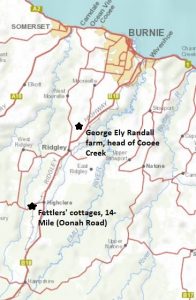
Emu Bay Railway south of Burnie, showing sites that George Randall may have hunted from. Base map courtesy of DPIPWE/
By 1907 Randall was a married man working at Dundas.[31] He did not return to the Burnie region after that, doing the rounds of Tasmania’s mining fields and rural districts for two decades with intermissions at Devonport, Hobart and Hokitika, the little mining port on the west coast of New Zealand’s South Island.[32] At Zeehan he was described as ‘the champion [wrestler] of Tasmania’, and he was noted not as a hunter but as a weightlifter and athlete.[33] More importantly, the blacksmith qualified as an engine driver and a winding engine driver, making him eminently employable in resource industries.[34] Randall finally settled at Hobart in 1929 at the age of 45.[35]
If we consider his Rouses Camp fettling a short aberration, the thirteen-year period in which Randall hunted around Burnie could have been approximately 1894 to 1906, that is, between the ages of ten and 22. The government bounty was available for the whole of this time, so why is there no record of George Randall’s prowess as a tiger tamer?
There are two possibilities. One is that Randall, a born showman, simply lied. The other possibility is that he killed or captured (he doesn’t say which) a lot of tigers but the evidence of same is hard to find.[36] There are few surviving records of the sale of live thylacines to zoos or animal dealers, or of bounty applications made through an intermediary like a hawker or shopkeeper. In some cases suspicion of acting as an intermediary even attaches to farmers—such as Charles Tasman (CT) Ford.
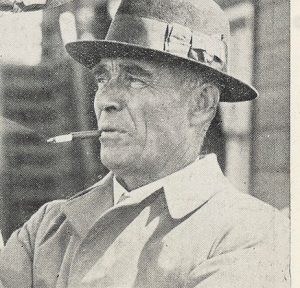
In later life Guildford’s Edward Brown assumed respectability as a breeder of race horses and hotelier. Stephen Spurling III photo from the Weekly Courier, 16 November 1922, p.28.
Randall may have been rewarded for fifteen thylacine carcasses through intermediaries such as shopkeepers, hawkers, skin buyers or some regular traveller to Burnie. Hunter/skin buyers such as Thomas Allen (15 adults and a juvenile, 1899–03)[40] and Edward Brown (7 adults, 1904–05)[41] operated in the Ridgley-Guildford area along the railway line, possibly accounting for some bounty payments for the likes of Randall, ‘Black Harry’ Williams, ‘Five-fingered Tom’ Jeffries and Bill Todd.
However, it does seem extraordinary that fifteen tiger captures or kills within the space of a month escaped public attention. We can assume that Randall never anticipated the scrutiny of his life that digitisation of records now allows us, let alone that someone who read his 1945 letter in the next century would try to dissect his life in order to verify his words. It is likely that Randall guessed that he had hunted in the Burnie region for thirteen years. Perhaps it was ten years, and perhaps his tigers took a lot longer to secure. Perhaps in a trunk in an attic somewhere is a mouldering trophy photo of the wrestler who wrangled tigers—dead or alive.
[1] GE Randall, ‘Native tigers’, Mercury, 12 December 1945, p.3.
[2] Born 1 July 1884, birth record no.1298/1884, registered at Emu Bay; died 14 July 1963, will no.44135, AD960/1/95, p.911 (TAHO), https://librariestas.ent.sirsidynix.net.au/client/en_AU/names/search/results?qu=george&qu=edward&qu=randall#, accessed 28 March 2020.
[3] ‘Capture of a native tiger’, Wellington Times and Agricultural and Mining Gazette, 12 May 1892, p.2.
[4] ‘A big tiger’, Wellington Times and Agricultural and Mining Gazette, 12 July 1892, p.2.
[5] Bounty no.147, 13 June 1892, LSD247/1/1 (TAHO).
[6] Bounty no.207, 21 July 1892, LSD247/1/1 (TAHO).
[7] Bounty no.190, 8 July 1892, LSD247/1/1 (TAHO).
[8] Bounty no.203, 21 July 1892, LSD247/1/1 (TAHO).
[9] Bounty no.118, 12 May 1892, LSD247/1/1 (TAHO).
[10] Bounty no.136, 31 May 1892, LSD247/1/1 (TAHO).
[11] Bounty no.204, 21 July 1892, LSD247/1/1 (TAHO).
[12] Bounty no.119, 12 May 1892; LSD247/1/1 (TAHO).
[13] Bounty no.188, 9 July 1892, LSD247/1/1 (TAHO).
[14] Bounty no.210, 21 July 1892, LSD247/1/1 (TAHO).
[15] Bounty no.135, 31 May 1892, LSD247/1/1 (TAHO).
[16] Bounty no.173, 27 June 1892, LSD247/1/1 (TAHO).
[17] Bounty no.148, 13 June 1892, LSD247/1/1 (TAHO).
[18] Bounty no.172, 27 June 1892, LSD247/1/1 (TAHO).
[19] Bounty no.189, 8 July 1892, LSD247/1/1 (TAHO).
[20] Bounty no.171, 27 June 1892, LSD247/1/1 (TAHO).
[21] Bounty no.206, 21 July 1892, LSD247/1/1 (TAHO).
[22] Bounty no.208, 21 July 1892, LSD247/1/1 (TAHO).
[23] Bounty no.117, 12 May 1892, LSD247/1/1 (TAHO).
[24] Bounty no.151, 20 June 1892, LSD247/1/1 (TAHO).
[25] ‘Waratah notes’, Wellington Times and Agricultural and Mining Gazette, 10 May 1892, p.3; ‘Housetop notes’, Wellington Times and Agricultural and Mining Gazette, 28 July 1892, p.2.
[26] ‘Longford notes’, Launceston Examiner, 14 July 1892, p.2; bounty no.236, 5 August 1892, LSD247/1/1 (TAHO).
[27] ‘Burnie: Police Court’, Daily Telegraph, 7 February 1894, p.1.
[28] ‘Wanted’, North Western Advocate and the Emu Bay Times, 11 July 1901, p.3.
[29] ‘For sale’, North Western Advocate and the Emu Bay Times, 31 January 1902, p.3.
[30] ‘Arson: case at Burnie’, North Western Advocate and the Emu Bay Times, 20 March 1902, p.3; ‘New insolvent’, Examiner, 29 April 1903, p.4.
[31] He married Ethel May Jones on 22 May 1907 at North Hobart (‘Silver wedding’, Mercury, 23 May 1932, p.1). Dundas: ‘To-night at the Gaiety’, Zeehan and Dundas Herald, 7 September 1907, p.3.
[32] Zeehan: Editorial, Zeehan and Dundas Herald, 31 August 1908, p.2; ‘Macquarie district’, Police Gazette Tasmania, vol.48, no.2595, 16 April 1909, p.81; Commonwealth Electoral Roll, Division of Darwin, Subdivision of Zeehan, 1914, p.2. Devonport: Commonwealth Electoral Roll, Division of Wilmot, Subdivision of Devonport, 1914, p.36. Waratah: ‘Waratah’, North Western Advocate and the Emu Bay Times, 17 October 1918, p.2; Commonwealth Electoral Roll, Division of Darwin, Subdivision of Waratah, 1919, p.14. Hobart: Commonwealth Electoral Roll, Division of Denison, Subdivision of Hobart East, 1922, p.30. Mathinna: ‘Personal’, Daily Telegraph, 30 September 1924, p.5. Cygnet: ‘Shooting at electric lines’, Mercury, 28 June 1926, p.4. Taranna: ‘Centralisation of school teaching’, Mercury, 12 May 1927, p.6. Hokitika: ‘Macquarie district’.
[33] Editorial, Zeehan and Dundas Herald, 31 August 1908, p.2; ‘Macquarie district’.
[34] Certificate of competency as second class engine drive, 1916, AA80/1/1, p.424, image 63 (TAHO), https://librariestas.ent.sirsidynix.net.au/client/en_AU/names/search/results?qu=george&qu=edward&qu=randall; Certificate of competency as mining engine driver, 1926, LID24/1/4, pp.109 and 109b (TAHO), https://librariestas.ent.sirsidynix.net.au/client/en_AU/names/search/results?qu=george&qu=edward&qu=randall#, accessed 28 March 2020.
[35] ‘Motor cycle registrations’, Police Gazette Tasmania, vol.68, no.3629, 8 February 1929, p.33.
[36] Randall mentioned using springers, the supple saplings used to ‘spring’ the snare, generally employed in footer snares, which caught the animal by the paw, not being designed to kill it. Many thylacines sent to zoos were captured in footer snares.
[37] Bounties no.365, 31 July 1891 (2 adults); no.204, 21 July 1892, LSD247/1/1; no.402, 9 January 1893; no.71, 27 April 1893 (2 adults); no.91, 5 May 1893; no.125, 19 June 1893; no.183, 24 July 1893, no.4, 23 January 1894 (2 adults); no.239, 22 September 1897 (3 adults, ‘August 2’); no.276, 4 November 1897 (2 adults, ’27 October’); no.379, 1 February 1898 (‘4 December’); no.191, 2 August 1898 (2 adults, ‘7 July’); no.158, 30 May 1899 (’26 May’); no.253, 30 August 1899 (3 adults, ’24 August’); no.254, 30 August 1899 (2 juveniles, ‘24 August’), LSD247/1/2 (TAHO).
[38] Bounties no.43, 27 February 1900 (3 adults, ’22 February’); no.250, 16 August 1900 (5 adults, ’26 July’); no.316, 3 October 1900 (4 adults, ’27 September’); no.398, 15 November 1900 (4 adults and 4 juveniles, ’28 October’); no.79, 13 March 1901 (2 adults, ’28 February’); no.340, 31 July 1901 (7 adults, ’25 July’); no.393, 28 August 1901 (6 adults, ‘2/3 August’); no.448, 3 October 1901 (’26 September’); no.509, 5 November 1901 (’24 October 1901’); no.218, 7 May 1903 (2 adults, ’24 April’); no.724, 17 November 1903 (4 adults); no.581, 21 June 1906, LSD247/1/2 (TAHO).
[39] Woolnorth farm journals, VDL277/1/1–33 (TAHO). The Woolnorth figure for 1900–06 excludes one adult and one juvenile killed by Ernest Warde and for which he claimed the government bounty payment himself (bounty no.190, 20 October 1904, LSD247/1/2 [TAHO]).
[40] Bounty no.374, 12 January 1899 (3 adults, ‘3 December’); no.401, 15 November 1900 (3 adults, ’15 June’); no.482, 21 January 1901 (3 adults, ’17 December’); no.22, 4 February 1901 (3 adults, ‘4 January’); no.985, 25 July 1902 (‘July’); no.1057, 27 August 1902 (’15 August’); no.1091, 17 September 1902 (‘4 September 1902’); no.462, 6 August 1903, (1 juvenile, ’24 July’), LSD247/1/ 2 (TAHO). See ‘Burnie’, North Western Advocate and the Emu Bay Times, 15 December 1900, p.2.
[41] Bounty no.233, 16 June 1904 (5 adults); no.125, 28 September 1905 (2 adults, ’31 August and 8 September’), LSD247/1/2 (TAHO).
by Nic Haygarth | 15/03/20 | Tasmanian high country history
In 1891 the Godkin Silver Mining Company (GSM Co) spent about £7000 building a horse-drawn tramway to service its mine before the value of the property was even established. Its mine manager, Arthur Richard (AR) Browne, was more interested in installing machinery at the property 13 miles (21 km) south-west of Waratah. He wanted the Godkin to not only control the mining field’s transport but to be its custom smelter.[i] The GSM Co’s early half yearly reports are a litany of grand installation plans fed by Browne’s delusional ore values: £10,000 worth of ore were said to be on the claim in September 1890; £70,000-£80,000 worth in March 1891.[ii]
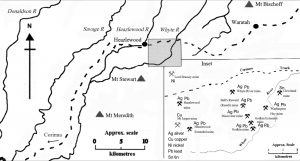
The mines on the 13-Mile silver field west of Waratah, Tasmania. The site of the village of Heazlewood on this map is the original site on the Heazlewood River. The village was later re-established further east. Base map drawn by the late Glyn Roberts.
However, the September 1891 report, tabled when Browne was on sick leave, painted a sobering picture of the mine. Only 27 tons of silver and lead ore from the southern section had been sold, for a profit of £218—not much of a return on the £7000 tramway.[iii] Directors were nervous.[iv] Notably, no banquet was called to celebrate completion of the second, 4-km-long stage of the Godkin Tramway to the Arthur River, which was tipped to occur in October 1891. No announcement of the achievement was ever made. Since the tramway never reached Waratah, it is safe to say that none of the construction costs were defrayed by hauling freight for other mining companies.
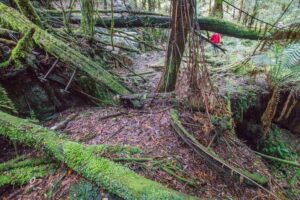
Remains of the headframe and flywheel at the South Godkin Shaft. Nic Haygarth photo.
Browne never returned to the Godkin, reportedly resigning in protest at directorial preference for tramway construction. His preference remained not proving the mine, but smelter building.[v] His last hurrah, delivered vicariously by Chairman of Directors TC Smart at the February 1892 half yearly meeting, was to compare the Godkin with Broken Hill mines and to continue to press for a smelter. Smart kept up the rhetoric, declaring in September 1892 that no Broken Hill mine had produced such rich ore at such a shallow level.[vi] When Browne returned to Tasmania in January 1893, it was as the Burnie agent for the Queensland Smelting Company, which envisaged buying ores from the new Tasmanian silver fields at the 13-Mile and Zeehan.[vii] Browne must have died an optimist in 1900 when, at the age of only 34, after stints at mines in Western Australia and British Columbia, he succumbed to asphyxia at the London home of his father, Lord Richard Browne.[viii]

The North Godkin Shaft today: pumps and windlass. Worthington pumps and a collapsed horse whim also help tell the story of the mine’s development and de-evolution. Nic Haygarth photo.
Despite securing another Broken Hill mining manager, Nathaniel Hawke, the GSM Co was already doomed.[ix] It had spent about £26,000 for a return of less than £300 when in 1892 government geologist Alexander Montgomery reported that it was no closer to success than when it started, having no payable ore on hand and needing to conduct deep sinking to prove its claim.
Montgomery also offered a cheaper alternative to deep sinking, but it was one which could never be definitive: driving a 1200-metre-long drainage tunnel from the Whyte River through both southern and northern leases to meet the engine shaft in the northern lease. While still working the upper, oxidised zone, this would test the entire property at a deeper level as well as drain it. The estimated cost of £2500–£3000 was well beyond the means of the GSM Co during tough economic times, and it succumbed to creditors in May 1894.[x] The surveyed township reserve of Stafford near the South Godkin site was never needed.
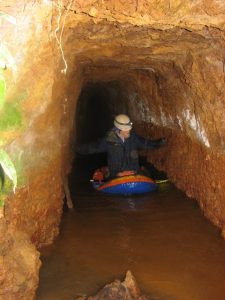
Paul Darby brown water rafting in Godkin Adit no.5. Nic Haygarth photo.
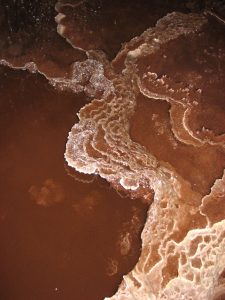
Gour pools in the Washington Mine Main Adit. A mixture of limestone and other minerals gives the 13-Mile mine workings rich calcite formations. Nic Haygarth.
The 13-Mile field today
The subsequent history of the 13-Mile mines is a typical one of de-evolution, both financial and technological. In the case of the Godkin, under-capitalised companies forced to revert to basic technology sought to exploit a lode that a heavily capitalised company had failed to even prove. The Victorian Magnet Company, which in 1912 completed the 1200-metre-long drainage tunnel, worked the North Godkin shaft using not a steam engine but a horse whim for motive power.[xi] By 1923 this company still used the Godkin Tramway to access the mine from the Corinna Road at Whyte River, but had converted it into a sledge track, the wooden rails having been torn up decades before in order to help build the nearby Whyte River Hotel.[xii] None of the 13-Mile mines was tested at depth until Electrolytic Zinc drilled the North Godkin site, Bell’s Reward, Discoverer and Godkin Extended in 1949—and the South Godkin Mine site remains undrilled to this day.[xiii] The likely presence of zinc in the Godkin’s pre-1917 finger dumps (that is, mullock that pre-dates the separation of zinc in Tasmania by the electrolytic process) and the possible presence of tin threaten to disturb what can now be seen as a fine historical mining interpretation site.
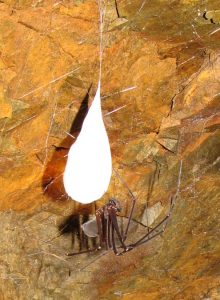
Hickmania troglodytes, Tasmanian cave spider with egg sac, Washington Hay Lower Adit. Nic Haygarth photo.
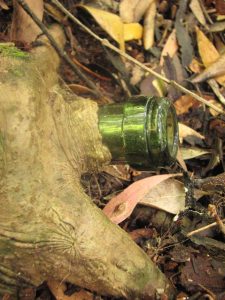
Well-rooted bottle, Godkin Mine. The tree root has grown around this discarded bottle over the course of nearly 130 years. Nic Haygarth photo.
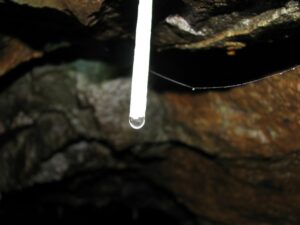
End of a calcite straw in one of the Godkin adits. Nic Haygarth photo.
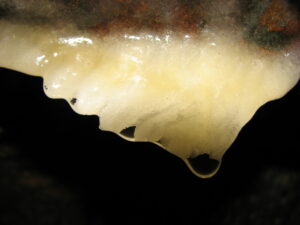
Calcite shawl in one of the Godkin adits. Nic Haygarth photo.
Aside from pilfering by visitors, the 13-Mile field has remained largely undisturbed for almost a century. With so many artifacts still in place and with more than 50 adits, shafts and other workings, this is one Tasmania’s most impressive mining heritage sites. The expenditure demonstrated by the Godkin and Godkin Extended Tramways (1889–92), Cornish boiler (1891), blacksmith’s shop, ship’s tank, steam pumps, windlass, flywheel and head frame tell the tale of a fanatical response to the Broken Hill silver boom of 1888, while the horse whim at the North Godkin shaft recalls the technological reversal of later years. Similarly, the main tramway, with its in places corduroyed formation, bridge ruins, discarded iron wheels, axles, sledge artifacts and branch tramways to other mines, demonstrates not only the GSM Co’s efforts to capitalise on the mining field’s transport needs, but the de-evolution of the Godkin.[xiv]
[i] ‘Meeting of the company’, Mercury, 8 January 1891, p.3.
[ii] ‘Meeting: Godkin SM Co’, Mercury, 26 September 1890, p.3; ‘Godkin SM Co’, Mercury, 26 March 1891, p. 3.
[iii] The company would sell only seven more tons of ore, to Kennedy and Sons and the Clyde Works in Sydney, in 1892.
[iv] ‘Godkin Silver Mining Co’, Mercury, 29 September 1891, p.4.
[v] ‘The Godkin Mine’, Launceston Examiner, 5 November 1891, p.4.
[vi] ‘Meetings: Godkin SM Co’, Mercury, 1 October 1892, supplement, p.1.
[vii] GVS Dunn to JW Norton Smith, Van Diemen’s Land Company, 31 May and 10 June 1892, VDL22/1/23; Arthur R Browne to JW Norton Smith, Van Diemen’s Land Company, 24 January 1893, VDL 22/1/23 (TAHO).
[viii] ‘Queenstown notes’, Zeehan and Dundas Herald, 12 May 1900, p.4; ‘Sudden death of Lord Richard Browne’s son at Reigate’, Sussex Agricultural Express, 28 April 1900, p.10.
[ix] Little is known of Hawke’s performance, but his ability to defend himself with a gun prompted a conviction for assaulting the mine’s dismissed engineer in August 1892 (editorial, Zeehan and Dundas Herald, 12 August 1892, p.2).
[x] Alexander Montgomery, Report on the Godkin Silver Mine, Geological Surveyor’s Office, Launceston, 1892, p.3; advert, Launceston Examiner, 14 May 1894, p.2.
[xi] Secretary of Mines Annual report for 1912, 1913, p.37.
[xii] Nye, The silver-lead deposits of the Waratah district, p.118.
[xiii] DI Groves, The geology of the Heazlewood–Godkin area, Department of Mines, Hobart, 1966, pp.37–39; Allegiance Mining, EL 14/2001 Heazlewood Area, Tasmania: partial relinquishment report, 2002, p.20.
[xiv] See also Parry Kostoglou, An archaeological survey of the historic Godkin Silver Lead Mine, Archaeological Survey Report, 1999/03, Mineral Resources Tasmania, Hobart, 1999.








































